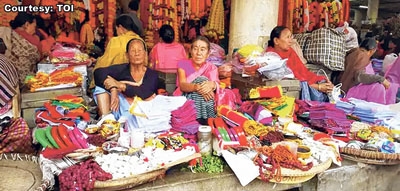Ima Manipur should smile more
|

Ranjan Yumnam
What is the gender of Manipur? I posed this simple question to one academic friend, and his answer surprised me. He threw another question at me. My friend asked: “You mean locating the gender of Manipur in the critical discourse of Manipur as a Nation?” The framing of his query felt quite sexist, morbid and clinical to my ears. My idea was to understand what kind of symbolism MANIPUR as an image evokes. As we all know, Manipur has always been perceived in the iconography as a mother figure, protective and nurturing. My intellectual friend turns the benign conversation into one between a post-mortem doctor and an Economics Professor. Locating what; a body organ ? What discourse—the Invisible Hand theory ?
THY NAME IS MOTHERLAND
Symbolism matters. Ma-ny countries identify them- selves culturally by notions of gender. Germans refer to their country as Father Land, as do Estonians, Norwegians, and Slavic Nationals. On the other hand, India is in the lap of Bharat Mata. Putin is Mother Russia’s son of the soil. This maternal bond is further stretched to the continental breadth by African countries naming theirs as “Mother Africa.” This mother/father business is a time-honoured tradition, and I quickly apologise to the trans community that I haven’t found any Nation birthed in a cis-neutral fashion. It seems the world is still trapped in a binary time warp and needs new dresses. Are patriarchy and feminism ganging up ?
In mythology, women are of all types, from loving to vicious. Greek mythology is replete with God- desses, Heroines, Harpies, Sirens, Muses, Nymphs and not so ugly mortals like Helen of Troy. Some of them are benevolent, and some are evil by modern moral standards. Hindu Goddesses like Kali and Durga are ambitious go-getters and protectors of their kin, but they can be mean and violent when provoked. If someone rubs them the wrong way, they have a hands-on policy of killing in many bloody ways.
In Ramayana, Sita is the epitome of wifely virtues: purity and loyalty. Among the Hindu pantheon of Goddesses, Parvati, Bhumi and Lakhsmi are worshipped for their generous blessings. Many Indian businessmen are devotees of Bhumi and Laksmi for reasons not limited to charity ! Draupadi is a special case. She is a dutiful wife to multiple Pandavas, but her endless sari disappoints the male gaze of Kauravas. With a little enthusiastic help from Bhagwan Krishna, her sari would never fall off and continue to become lengthier than the entire epic of Mahabharata itself. After the failed attempt at disrobing Draupadi, all diplomatic relationships between Pan-davas and Kauravas were stripped resulting in the great war of Maha-bharata.
BIRTH AND REBIRTH
In Western mythology, the Earth and all the lives inhabiting it were created by Gaia, the first of the Greek Goddesses. (Male Gods like Zeus, Poseidon, Hades etc. were her mistakes). According to Vedic origin myths, the Lord Brahma created the universe out of nothing. His virile powers did not require any female and male entities mating to make. But Brahma’s creation story has an interesting female twist. This twist was necessary because the world got too crowded with people and the lives he created while the Earth had only limited resources. The shortage of food and housing became a major problem. To solve this problem, He created a woman called Death out of his own flesh. When he told the woman the great responsibility of introducing death on Earth, she tried to avoid it hiding herself in all the nooks and corners of the world. But it was futile. Lord Brahma could see everything. Saying that life becomes more meaningful with death, the Creator God told Death: “Hush, daughter. Listen. Death shall not be evil, or cruel, or without virtue. Without death, there can be no peace, no rest for the suffering, the aged. Without death, there can be no rebirth. Daughter, death shall not be the destroyer of the world, but protector.” Profound words. Whether he also meant that men were disposable, we would never know for sure.
REFRESH THE WARDROBE
When it comes to the personification of Manipur, the mother metaphor is apt. Her portrayal in popular culture is that of a helpless middle-aged woman in tattered clothes whose dignity needs to be defended at all costs. Our songs, poetry and movies are a testament to this image of Manipur as a vulnerable woman, a damsel in distress. She is the mother bound in our homes. To protect her, we created the special department of “Home’’ Affairs. In this process, she is robbed of all her agency in the Nation-making and defence narra- tive while patriotism is projected as a masculine duty.
We need a better metaphor for Manipur, one that encompasses the full spectrum of womanhood, including both negative and positive predilections. A woman could be young or old, a mother, a maiden, a fairy, a witch, a warrior, a saint, provocative or taunting, gentle or wise, and many more. She could also be a sister, a wife, a mother, or a daughter. Most of all, she could be an equal partner, both in reality and emblematic representation.
In fact, there is an anima in men and an animus in women, like an androgynous body was separated into two genders at some point in the evolutionary history of the human species. So, which type of woman should we prefer to represent Manipur ? In my view, the first step is to refresh her wardrobe and make her more cheerful, strong, and modern, like her many high-achieving dau-ghters. My academic friend would agree, hopefully.

